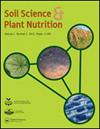Cadmium in soils and potato tubers under grower management in two contrasting soil types of Hokkaido, Japan
IF 1.8
4区 农林科学
Q3 ENVIRONMENTAL SCIENCES
引用次数: 1
Abstract
ABSTRACT In Japan, little has been reported on cadmium (Cd) concentration in upland soils, and its relation to Cd concentration in crops and vegetables other than rice. Cd concentration in the surface soils and potato tubers of growers’ fields in two main potato production areas in Japan with contrasting soil types (Andisols and Inceptisols) was investigated. Soil and tuber samples were obtained from 90 growers’ fields with variable management histories. Total and Mehlich-3 soil Cd concentration were determined, and Cd concentration in the peeled potato tubers was also measured. A significant positive correlation was found between total Cd and phosphorous concentration in the soils reflecting the historical heavy application of phosphate fertilizer in both soil types. Although the total Cd concentration was much higher in Andisols, the Mehlich-3 Cd as well as tuber Cd concentration was lower in Andisols than in the Inceptisols, suggesting that Cd in Andisols may be specifically adsorbed by humic substances and amorphous clay minerals. The Cd concentration of the peeled potatoes in all samples was less than 100 μg kg−1 fresh weight below the threshold set by the Codex Alimentarius guidelines. The Cd concentration in the tubers tended to be higher when the soil phosphate retention index and base saturation were lower, and this tendency was stronger when both conditions are satisfied. Differences in soil properties and not the total soil Cd concentration were the dominant factor affecting potato tuber Cd accumulation. It is quite possible to reduce the amount of phosphate fertilizer appropriately to minimize the accumulation of Cd in both soil types as well as by increasing the soil base saturation to suppress the transfer of Cd from the soils to the potato tubers is especially important in the Inceptisols.日本北海道两种不同土壤类型种植管理下土壤和马铃薯块茎中的镉
在日本,关于旱地土壤镉(Cd)浓度及其与水稻以外作物和蔬菜镉浓度的关系的报道很少。研究了日本两个马铃薯主产区不同土壤类型(andiols和Inceptisols)的土壤表层土壤和马铃薯块茎中镉的含量。土壤和块茎样本来自90个不同管理历史的种植者的田地。测定了土壤总镉和Mehlich-3镉含量,并测定了马铃薯去皮块茎中镉含量。土壤中总Cd与磷浓度呈显著正相关,反映了两种土壤类型历史上大量施用磷肥。虽然土壤中Cd的总浓度要高得多,但土壤中mehlich - 3cd和块茎Cd的浓度却比土壤中低,说明土壤中的Cd可能被腐殖质和无定形粘土矿物特异性吸附。所有样品中去皮马铃薯的Cd浓度均低于100 μg kg - 1鲜重,低于食品法典准则规定的阈值。土壤磷保持指数和碱饱和度越低,块茎中Cd浓度越高,两者同时满足时这种趋势更强。影响马铃薯块茎Cd积累的主要因素不是土壤总镉浓度,而是土壤性质的差异。适当减少磷肥的用量,以尽量减少两种土壤类型中镉的积累,以及通过增加土壤基饱和度来抑制镉从土壤向马铃薯块茎的转移,这在初期土壤中是非常重要的。
本文章由计算机程序翻译,如有差异,请以英文原文为准。
求助全文
约1分钟内获得全文
求助全文
来源期刊

Soil Science and Plant Nutrition
农林科学-农艺学
CiteScore
4.80
自引率
15.00%
发文量
56
审稿时长
18-36 weeks
期刊介绍:
Soil Science and Plant Nutrition is the official English journal of the Japanese Society of Soil Science and Plant Nutrition (JSSSPN), and publishes original research and reviews in soil physics, chemistry and mineralogy; soil biology; plant nutrition; soil genesis, classification and survey; soil fertility; fertilizers and soil amendments; environment; socio cultural soil science. The Journal publishes full length papers, short papers, and reviews.
 求助内容:
求助内容: 应助结果提醒方式:
应助结果提醒方式:


